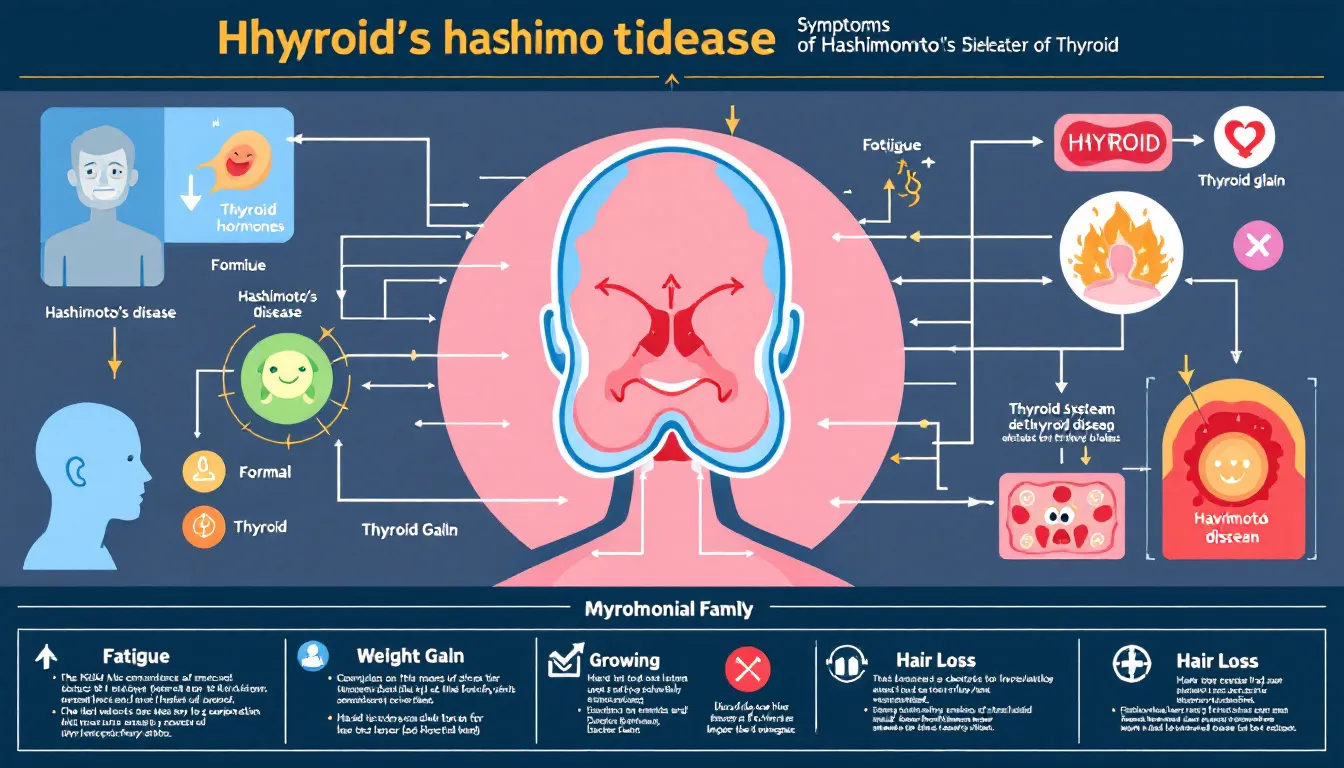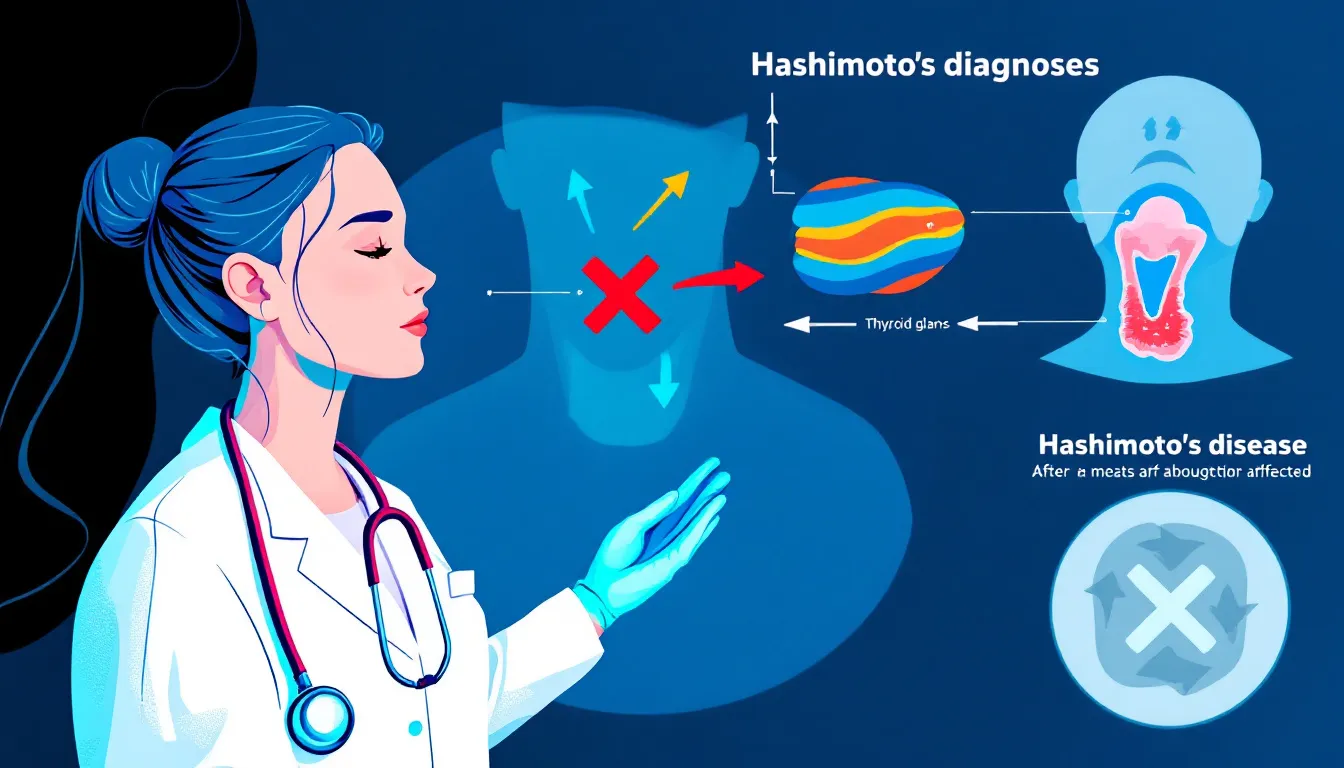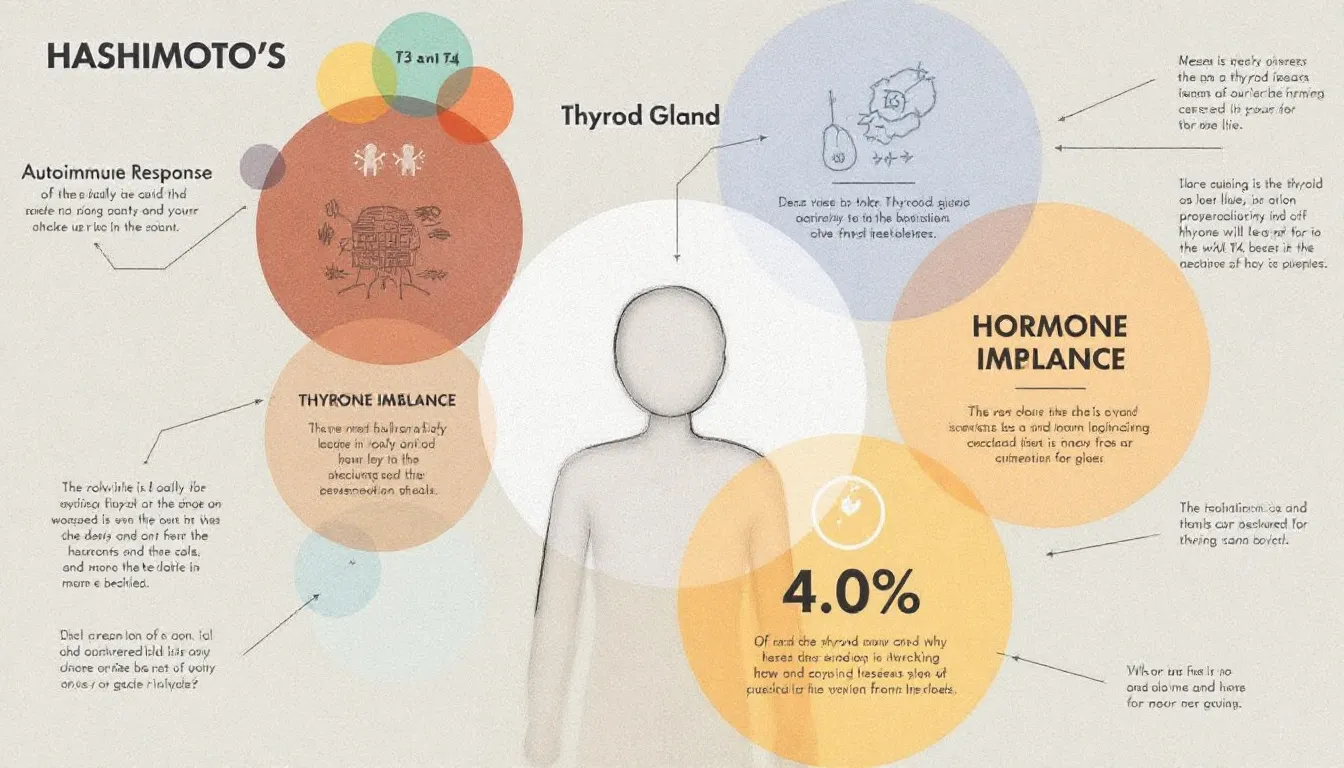Hashimoto’s disease is an autoimmune disorder targeting the thyroid gland. This article covers its symptoms, causes, diagnosis, and treatment options.
Key Takeaways
- Hashimoto’s disease is an autoimmune disorder affecting the thyroid, leading to hypothyroidism, and is most prevalent in middle-aged women.
- Diagnosis involves physical examinations, symptom assessments, and blood tests for thyroid hormone levels and autoantibodies, with early detection being crucial for effective management.
- Treatment primarily includes lifelong levothyroxine therapy, regular monitoring of thyroid hormone levels, and lifestyle modifications to support overall health.
What is Hashimoto’s Disease?

Hashimoto thyroiditis is an autoimmune disorder that targets the thyroid gland, a small but crucial organ in your neck responsible for regulating various body functions through thyroid hormone production. In Hashimoto thyroiditis, the immune cells mistakenly attack the thyroid gland, leading to its gradual destruction and an autoimmune response. This process often results in a decline in the production of thyroid hormones, which are essential for maintaining the body’s metabolism, energy levels, and overall health. Additionally, immune system attacks can exacerbate the condition over time.
The thyroid gland produces hormones that influence nearly every cell, tissue, and organ. When it doesn’t produce enough hormones, as often happens in Hashimoto’s disease, metabolic processes slow down, leading to fatigue, weight gain, and depression. This condition is known as severe hypothyroidism, which is a common cause of hypothyroidism of Hashimoto’s disease and can also be referred to as an underactive thyroid.
Hashimoto’s disease, also known as chronic lymphocytic thyroiditis, affects about 2% of the world’s population and is particularly common in middle-aged women. Despite its prevalence, many people remain unaware of the condition until symptoms become severe. Understanding the nature of Hashimoto’s disease and thyroid diseases is the first step in managing it effectively.
Causes and Risk Factors
The development of Hashimoto’s disease is a complex interplay of genetic and environmental factors. If you have a family history of thyroid dysfunction or autoimmune diseases, your risk of developing Hashimoto’s disease is significantly higher. Specific genetic factors, such as familial predisposition and immune regulatory genes, play a pivotal role in this heightened risk.
Women, particularly those in middle age, are significantly more prone to developing Hashimoto’s disease than men, with the condition being four times more frequent in women. Environmental factors, such as exposure to high levels of radiation, also contribute to the risk. Both excessive and insufficient iodine intake can lead to the production of thyroid autoantibodies, increasing the likelihood of developing this autoimmune disorder called hashimoto’s thyroiditis in people with Hashimoto’s disease.
Having other autoimmune conditions, such as rheumatoid arthritis or lupus, also increases the risk of developing Hashimoto’s disease. Monitoring family history and being aware of these risk factors can help in early detection and management of the autoimmune conditions.
Hashimoto’s thyroiditis can manifest at any age, though it is most prevalent in middle-aged individuals. Understanding these risk factors and underlying mechanisms allows individuals to take proactive steps to manage their health and potentially mitigate the development of Hashimoto’s disease.
Symptoms of Hashimoto’s Disease

The symptoms of Hashimoto’s disease can be subtle at first, developing gradually over time. Common signs include:
- Fatigue
- Weight gain
- Depression
- The presence of a goiter, which is an enlarged thyroid gland, along with hypothyroid symptoms.
These symptoms are often mistaken for other health issues, leading to delays in diagnosis and treatment.
As the condition progresses, individuals may experience increased fatigue, weight gain, and cold intolerance. Emotional challenges such as anxiety and depression are also common among people with Hashimoto’s disease, necessitating changes in management strategies to improve mental health. The gradual onset of these symptoms can make living with Hashimoto’s particularly challenging, as they slowly erode one’s quality of life.
One of the initial signs of Hashimoto’s disease is often an enlarged thyroid, known as a goiter. This can cause visible swelling in the neck and may lead to discomfort or difficulty swallowing. Recognizing early symptoms is vital for timely diagnosis and intervention.
Daily life with Hashimoto’s disease can be significantly impacted by these symptoms. Fatigue and weight gain can make physical activity and maintaining a healthy lifestyle more challenging, while depression and anxiety can affect mental health and overall well-being. Recognizing these symptoms and their effects is key to effective management and improved quality of life.
Diagnosis of Hashimoto’s Disease

Diagnosing Hashimoto’s disease typically involves a thorough physical examination, a detailed review of medical history, and an assessment of symptoms. Your healthcare provider will look for signs such as an enlarged thyroid gland and discuss your symptoms and family history of thyroid or autoimmune diseases.
Blood tests play a crucial role in diagnosing Hashimoto’s disease. These tests measure levels of thyroid-stimulating hormone (TSH), T4, and T3, along with checking for the presence of anti-thyroid antibodies. Elevated TSH levels, coupled with low levels of thyroid hormones, indicate hypothyroidism, a common outcome of Hashimoto’s disease. The presence of thyroid peroxidase antibodies (TPO antibodies) is a strong indicator of Hashimoto’s thyroiditis.
In some cases, an ultrasound may be performed to evaluate the thyroid gland’s structure. This imaging test can reveal structural abnormalities such as diffuse vascularity and the presence of pseudo nodules, which are indicative of inflammation. Ultrasound evaluations help provide a clearer picture of the extent of thyroid damage and aid in confirming the diagnosis.
Early and accurate diagnosis is vital for effective management. Identifying the condition early allows for timely intervention, helping prevent further thyroid damage and alleviate symptoms. Regular monitoring and follow-ups with your healthcare provider are key to managing this chronic autoimmune disorder and thyroid disorders, as recommended by the American Thyroid Association. Thyroid autoimmunity is an important aspect to consider in this context.
Treatment Options for Hashimoto’s Disease

Managing Hashimoto’s disease requires a comprehensive approach that includes lifelong medication and regular monitoring of thyroid hormone levels. Levothyroxine therapy is the standard treatment for hypothyroidism, aiming to restore and maintain adequate thyroid hormone levels. Consistent medication routines and symptom tracking can significantly improve the quality of life for people with Hashimoto’s disease.
While surgery is not the initial treatment option, a thyroidectomy may be considered in cases where there are significant pressure symptoms or cosmetic concerns. However, most individuals with Hashimoto’s disease can effectively manage their condition with medication and lifestyle modifications.
Levothyroxine Therapy
Levothyroxine is the cornerstone of treatment to treat hypothyroidism in Hashimoto’s disease. This synthetic thyroid hormone is taken once a day, preferably in the morning before eating, to ensure optimal absorption.
The dosage of levothyroxine is tailored to each individual based on factors such as:
- age
- weight
- residual thyroid function
- other medical conditions
Regular blood tests are crucial for monitoring TSH levels after starting levothyroxine therapy. TSH levels should be retested approximately 6 to 10 weeks after any dosage adjustment and then annually to ensure that thyroid hormone levels remain within the normal range. Even with mild hypothyroidism, regular TSH tests are recommended.
The main objective of levothyroxine treatment is to restore adequate T-4 hormone levels. It also aims to maintain these levels over time. T-4 is converted into T-3 in the body, providing the necessary thyroid hormone supply for various bodily functions. Achieving and maintaining these hormone levels can alleviate symptoms and improve overall well-being.
Patients must adhere to their prescribed regimen and communicate any changes in symptoms or concerns to their healthcare provider. Regular follow-ups and blood tests are vital for effective management and ensuring treatment success.
Lifestyle and Dietary Considerations
Lifestyle and dietary considerations play a significant role in managing Hashimoto’s disease. While iodine is essential for thyroid hormone production, excessive intake can worsen hypothyroidism, so it is crucial to maintain a balanced intake to prevent iodine deficiency. Nutrients like iron and vitamin D can improve thyroid function and should be included in the diet.
Certain foods and supplements, such as high-fiber foods and soy, can interfere with the absorption of levothyroxine. It is essential to manage the timing of these foods and supplements to avoid interference with medication. Dietary modifications, such as adopting an anti-inflammatory or gluten-free diet, may help mitigate some symptoms associated with Hashimoto’s disease.
A balanced diet and proper nutrition can support overall health and manage immune responses linked to Hashimoto’s disease. Lifestyle modifications, including stress reduction techniques, can contribute to reducing the risk of developing Hashimoto’s disease. Regular physical activity is also beneficial in alleviating symptoms and enhancing the overall quality of life.
A healthy lifestyle with regular exercise, a balanced diet, and stress management is beneficial for those with Hashimoto’s disease. Such lifestyle changes can complement medical treatment and enhance overall well-being.
Alternative Treatments
In addition to conventional treatments, some alternative treatments may benefit individuals with Hashimoto’s disease. Selenium supplementation has shown promise in improving thyroid function, particularly in regions where selenium deficiency is common. Selenium helps reduce thyroid peroxidase antibody levels, which can improve overall thyroid health.
Zinc supplementation may also have potential benefits for thyroid health by increasing free T3 levels. Both selenium and zinc can support thyroid function, but it is essential to monitor and consider individual needs before starting any supplementation.
While these alternative treatments can be beneficial, they should not replace conventional thyroid hormone replacement therapy. Discuss any alternative treatments with a healthcare provider to ensure they are safe and effective for your specific situation.
Managing Thyroid Hormone Levels
Managing thyroid hormone levels is a critical aspect of living with Hashimoto’s disease. Regular TSH level monitoring is essential for effective levothyroxine dosage adjustments. The recommended frequency for thyroid function testing in individuals with Hashimoto’s thyroiditis is annually.
Initially, blood tests should be performed every 6 to 8 weeks after starting treatment, then every 6 months, and annually thereafter. Dosage adjustments may be necessary over time to maintain normal hormone levels. TSH levels should be reassessed every 6 to 10 weeks until optimal levels are achieved.
Immunoassay tests can sometimes overestimate hormone levels, leading to inadequate treatment of hypothyroidism. Therefore, it is essential to use accurate and reliable thyroid function tests. Additional indicators for thyroid function beyond TSH, such as NT4 and T3, can provide a more comprehensive understanding of thyroid hormone action.
Diligently monitoring hormone levels and making necessary adjustments allows individuals with Hashimoto’s disease to effectively manage their condition and maintain a good quality of life.
Potential Complications
Hashimoto’s disease can lead to several potential complications if not properly managed. One of the most serious complications is the increased risk of developing primary thyroid lymphoma. This type of thyroid malignancy constitutes between 0.5% to 5% of all thyroid cancers found in patients with Hashimoto’s thyroiditis. The risk of developing primary thyroid lymphoma is significantly higher in those with a long history of the disease, being 67 to 80 times greater.
The relationship between Hashimoto’s thyroiditis and papillary thyroid carcinoma is less clear, complicating the assessment of thyroid malignancy risk. However, it is essential to monitor for any signs of thyroid cancer and consult a healthcare provider for regular check-ups.
Pregnancy complications are another concern for women with Hashimoto’s disease. These can include gestational diabetes and an increased risk of miscarriage. Untreated hypothyroidism linked to Hashimoto’s can result in severe pregnancy outcomes, including fetal death and low birth weight.
Regular monitoring and effective management are crucial to prevent complications. Staying proactive and working closely with healthcare providers helps minimize the risk factor of severe health issues.
Preventing Hashimoto’s Disease
Preventing Hashimoto’s disease involves managing risk factors, especially for high-risk individuals. Environmental factors, such as maintaining balanced iodine and selenium levels, play a significant role in disease development. Lifestyle choices, including stress management and maintaining a healthy diet, can also help to prevent Hashimoto’s disease.
Early detection through clinical trials and regular testing for thyroid peroxidase antibodies can help identify potential cases of Hashimoto’s disease before they become severe. Women who have been pregnant should undergo thyroid peroxidase antibodies testing for early detection of Hashimoto’s disease.
Addressing these factors and staying vigilant allows individuals to take proactive steps to prevent the onset of Hashimoto’s disease and maintain optimal thyroid health.
Living with Hashimoto’s Disease

Living with Hashimoto’s disease requires ongoing management and lifestyle adjustments. One significant impact of Hashimoto’s is on fertility; hormonal imbalances related to thyroid hormone deficiency can lead to decreased libido and irregular menstrual cycles. For those trying to conceive, managing thyroid levels is crucial to increase the chances of a successful pregnancy.
Despite treatment, about 10-15% of patients treated with levothyroxine experience dissatisfaction due to persistent symptoms. Maintaining open communication with healthcare providers is essential to adjust treatment plans as needed. If a dose of levothyroxine is missed, patients should consult their doctor for guidance on the next steps.
A healthy lifestyle, including regular exercise, good sleep, and stress management, can significantly benefit those living with Hashimoto’s disease. These lifestyle choices can help manage symptoms and improve overall well-being. Staying proactive and maintaining a balanced lifestyle allows individuals with Hashimoto’s disease to lead fulfilling lives.
Summary
In summary, Hashimoto’s disease is a chronic autoimmune disorder that affects the thyroid gland and leads to hypothyroidism. Understanding the symptoms, causes, risk factors, and treatment options is crucial for managing this condition effectively. Regular monitoring, levothyroxine therapy, and lifestyle adjustments play vital roles in maintaining thyroid hormone levels and overall health.
Living with Hashimoto’s disease can be challenging, but with proper management and support, individuals can lead healthy and fulfilling lives. By staying informed and proactive, you can take control of your health and navigate the complexities of this condition with confidence and resilience.
Frequently Asked Questions
What is Hashimoto’s disease?
Hashimoto’s disease is an autoimmune disorder that progressively damages the thyroid gland, resulting in hypothyroidism. This condition can affect your overall health and requires ongoing management.
What are the common symptoms of Hashimoto’s disease?
Common symptoms of Hashimoto’s disease are fatigue, weight gain, depression, and an enlarged thyroid gland (goiter). If you experience these symptoms, it may be beneficial to consult a healthcare professional for evaluation.
How is Hashimoto’s disease diagnosed?
Hashimoto’s disease is diagnosed through a physical examination, medical history review, blood tests assessing thyroid function and the presence of anti-thyroid antibodies, and occasionally an ultrasound. This comprehensive approach ensures an accurate diagnosis.
What is the standard treatment for Hashimoto’s disease?
The standard treatment for Hashimoto’s disease is daily levothyroxine therapy, which helps maintain normal thyroid hormone levels. This approach effectively addresses the hormonal imbalance caused by the condition.
Can lifestyle changes help manage Hashimoto’s disease?
Absolutely, lifestyle changes such as a balanced diet, regular exercise, and effective stress management can significantly aid in managing Hashimoto’s disease and enhancing overall well-being.
